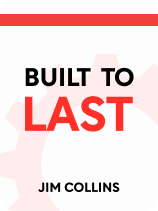

This article is an excerpt from the Shortform book guide to "Built to Last" by Jim Collins and Jerry Porras. Shortform has the world's best summaries and analyses of books you should be reading.
Like this article? Sign up for a free trial here .
What are some BHAG examples? How have visionary leaders succeeded by committing to these goals?
Researchers Jim Collins and Jerry I. Porras found that visionary companies set and achieve Big Hairy Audacious Goals (BHAGs). They share three steps to creating your own BHAGs and four ways to make sure they succeed. They also provide several BHAG examples for instruction and inspiration.
Keep reading to see several BHAG examples and to learn how to implement your own.
Commit to Big Hairy Audacious Goals
It’s a myth that successful companies are conservative and prefer not to make bold moves.
The Built to Last research revealed that far from being overly cautious, visionary companies in fact set risky, progress-stimulating goals—what Jim Collins and Jerry I. Porras have coined Big Hairy Audacious Goals (or BHAGs, pronounced bee-hags). BHAGs are goals that take you out of your comfort zone and require a strong commitment to see them through. They typically take 10 to 30 years to achieve and only have a 50- to 70-percent probability of success, but you should be able to look at them and believe that you can achieve them.
If you’re an entrepreneur, then you’re no stranger to BHAGs, as getting a business off the ground is already a BHAG in itself. If you work for a company, you can pursue BHAGs at any level, whether it’s within your team or within the entire corporation.
- BHAG example: If you’re a new hire in the accounting department of a big corporation, your BHAG might be to become the vice president of finance within 15 years.
Visionary companies use four different types of BHAGs:
- Ambition: This can be a quantitative or qualitative target that you want to reach. BHAG example: A fledgling fast-food restaurant might have a BHAG of selling 100 million burgers within 10 years.
- Challenger: This focuses on beating the competition, a specific strong player in the industry. BHAG example: A yoga wear company’s BHAG might be to unseat Lululemon as the most recognizable brand in the industry.
- Icon: This focuses on emulating a successful company, which may or may not be in the same industry. It’s particularly great for new businesses. BHAG example: A new manufacturing company’s BHAG might be to become as globally recognizable as 3M.
- Refresher: This might be a shift in the product offerings or a revamp of a company’s image. It’s especially effective for old or big organizations. BHAG example: A company known for cheap, low-quality cosmetics might set a BHAG to become a respected player in the skincare industry.
The 3 Steps to Creating Your BHAG
A BHAG isn’t a vague and verbose mission statement that no one can remember—it’s clear, compelling, challenging, and risky, while also reinforcing the core ideology. There are three steps to coming up with your BHAG.
1) Clarify the Language Around Your Goal
It should be a precise goal that’s easy to understand, not a meaningless statement that needs explanation. “Land a man on the moon” is a much more direct and exciting goal to shoot for than, “Improve the space program.” It paints a compelling picture of the finish line, inspires people, and ignites team spirit. It creates momentum and galvanizes people into action.
(Shortform note: Read our guide to Switch to learn more about the changemaking power of painting a vivid picture of your destination.)
2) Reflect on Your Goal’s Audacity
If it’s easy to achieve, then it’s not big, hairy, and audacious. A BHAG should push your company out of its comfort zone, because that’s where growth and progress happens. You’ll need a great deal—even an unreasonable amount—of confidence that you can do something that outsiders may deem absurd or impossible.
3) Check Your Goal’s Alignment With Your Core Philosophy
Just as visionary companies don’t live on core philosophy alone, neither do they rely solely on BHAGs for long-term success. They pursue only those BHAGs that reinforce their ideals. While core philosophy serves as a solid, stable platform from which to launch their BHAGs, the BHAGs serve as a non-core practice that brings the ideology to life. Again, they use the power of and to both maintain the core and stimulate progress.
- BHAG example: Boeing stayed true to their core philosophy of being pioneers and innovators in aviation, even as they set new BHAGs and built one ambitious plane after another.
An excellent BHAG example is U.S. President John F. Kennedy’s goal in 1961 to put a man on the moon within the decade. The pronouncement was clear and ambiguous, expressing a direct and exciting goal. It was seemingly outrageous, with a 50-50 chance of success. And it aligned with JFK’s mission to get America moving speedily forward again after a lethargic decade.
The 4 Ways to Ensure Your BHAG’s Success
Achieving a BHAG is extremely challenging and takes extraordinary drive and commitment. There are four ways to increase your chances of accomplishing your BHAG.
1. Fully commit to it. It’s not enough to have a BHAG; you also need to be willing to do whatever it takes to achieve it.
- BHAG example: In 1965, Boeing put everything on the line to develop the 747 jumbo jet—Chairman William Allen expressed that he was willing to use all of the company’s resources to do so. This BHAG was nearly the company’s downfall at first—Boeing had to lay off 86,000 people over three years due to slow sales, but they didn’t give up. The 747 eventually became the flagship jumbo jet of the airline industry.
(Shortform note: In Great by Choice, Collins introduces the concept of “leading above the Death Line,” which means avoiding big risks that can kill a company. This seems to run counter to BHAGs. He addresses this and emphasizes the importance of and: Companies should pursue BHAGs and stay above the Death Line. Read our full summary of Great by Choice.)
2. Look beyond the money. As we’ve discussed, visionary companies are driven by something greater than profit. They are driven by a compelling urge to keep pushing the bounds of impossibility while remaining firmly grounded in their core ideology.
- BHAG example: In the past, wholesalers would purchase large quantities of goods from Procter & Gamble (P&G) every few months, which meant P&G had to constantly hire and fire workers to meet the intermittent demand. The company put an end to the practice by committing to a BHAG: They would bypass wholesalers and go straight to retailers, enabling the company to employ workers year-round. P&G had to open hundreds of warehouses and build a massive salesforce but P&G president Richard Deupree saw the steady employment of thousands of workers as worth the risk. It was aligned with the company’s core ideologies of respect and concern for the individual, continuous self-improvement, and honesty and fairness. They achieved their BHAG within four years.
3. Make it institutional. A BHAG should be built into the organization and should be exciting enough to maintain momentum, transcending any disruptions such as a change in leadership.
- BHAG example: Citicorp started out as a small regional bank called City Bank in the 1890s. Then-president James Stillman set the BHAG “to become a great national bank,” and leader after leader picked up from where their predecessor left off, until Citicorp accomplished their BHAG.
4. Keep setting more BHAGs. Visionary companies aren’t complacent; they know that the work isn’t done just because they’ve reached a goal. Instead, they have other BHAGs lined up and employ other ways to stimulate progress. Without another BHAG to pursue, they end up becoming stagnant.
- BHAG example: Ford had only a 15 percent market share but worked hard to take the number one spot from GM. Having reached their BHAG, Ford became complacent, which gave GM a chance to reclaim the top spot.

———End of Preview———
Like what you just read? Read the rest of the world's best book summary and analysis of Jim Collins and Jerry Porras's "Built to Last" at Shortform .
Here's what you'll find in our full Built to Last summary :
- The key to longevity and success for your company
- Debunking the twelve myths about what it takes to build a visionary company
- The four key concepts behind enduring greatness






